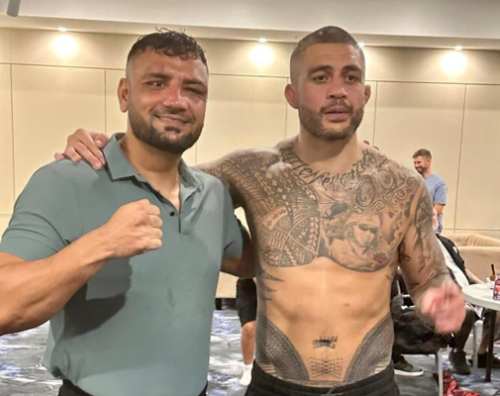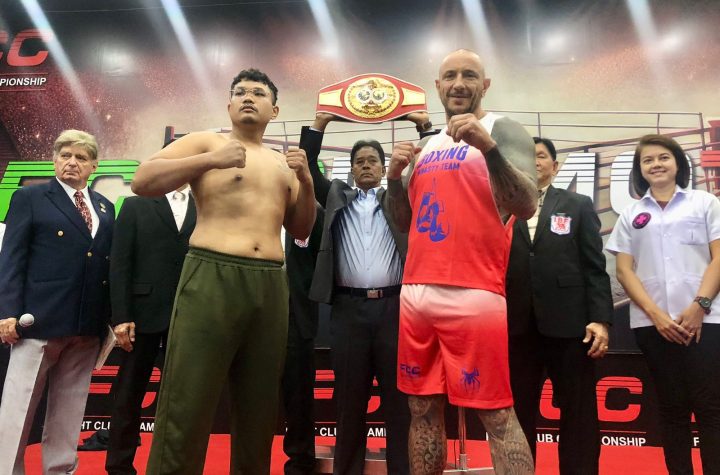
By Scott Christ
Badlefthook.com
Few fighters have turned pro with the sort of hype and expectation that accompanied Vasiliy Lomachenko when he stepped into the paid ranks on Oct. 12, 2013.
The Ukrainian southpaw had an incredible amateur career. He broke through at the 2007 World Championships in Chicago, losing in the final to Russia’s Albert Selimov. It would be his last loss in the amateur ranks.
As a featherweight, he won gold at the 2008 Olympics and 2009 World Championships. As a lightweight, he won gold at the 2011 World Championships and 2012 Olympics.
As an Olympian, he not only won the two gold medals, but also the Val Barker Trophy as the outstanding boxer of the tournament in 2008. He was a finalist for the award again in 2012.
All in all, Lomachenko went a reported 396-1 as an amateur. He twice avenged his lone loss. He dominated, and he has an argument as the greatest amateur fighter of all time.
So yes, when he signed with Top Rank and made his pro debut, it was a big deal, and a lot was expected.
Lomachenko and his team made clear right away that they weren’t looking to do some slow burn showcase thing to pad a pro record, too. His very first fight was a 10-rounder against Jose Ramirez, certainly no star but a gatekeeper sort with a 25-3 record and a recent road win over Rey Bautista in the Philippines.
Lomachenko knocked Ramirez out in the fourth round and decided to shoot his shot in fight number two, going after the WBO featherweight title, held by rugged Mexican veteran Orlando Salido.
Salido won the fight, and it’s been touted ever since as a professional learning experience for Lomachenko. But a few things about that:
- Salido missed weight, coming in more than two pounds over the limit
- Salido landed a ton of low blows that excellent Texas referee Laurence Cole just missed or ignored
- The fight wound up being close, and the judges had a split decision (I scored it for Salido, I’m not arguing they made the wrong call)
- Lomachenko nearly stopped Salido in the 12th round
All I’m saying is that for a fight that is now seen largely as simply “Lomachenko’s Loss” and a fight where a dirty old veteran taught him some tricks of the trade, he still almost won. That’s the level of talent Lomachenko has.
:no_upscale()/cdn.vox-cdn.com/uploads/chorus_asset/file/16018330/451023156.jpg.jpg)
Instead, Lomachenko had to wait an eternity to win a world title in his third pro fight, a little over three months later. He took the now-vacant WBO 126-pound belt with a majority decision win over Russell, a fight that was really clearly taken by Lomachenko, despite Lisa Giampa’s even scorecard.
It was also a study in what records mean. Entering 1-1, Lomachenko outclassed Russell, who had a padded 24-0 record. This is not to say that Russell isn’t a fantastically talented fighter, because he is. He’s gone on to win the WBC featherweight title, and out of his three title defenses, one of them was even against an actual contender.
Lomachenko had some trouble finding really quality opponents after the Salido and Russell fights. He shut out Chonlatarn Piriyapinyo in Nov. 2014, then knocked out Gamalier Rodriguez on the Mayweather-Pacquiao undercard in 2015. He defended again in Nov. 2015, knocking out Romulo Koasicha.
Since the featherweights weren’t fighting him, he decided to move up to 130 pounds, immediately facing veteran titleholder Roman “Rocky” Martinez. He smoked Martinez, crushingly stopping him in the fifth round to win another WBO belt.
His defenses at 130:
- Nicholas Walters, Nov. 2016. Walters, an unbeaten former titleholder at 126, quit after seven rounds, and hasn’t fought since.
- Jason Sosa, April 2017. Sosa quit after nine rounds.
- Miguel Marriaga, Aug. 2017. Marriaga quit after seven rounds.
- Guillermo Rigondeaux, Dec. 2017. Rigondeaux, himself a former amateur legend and a world champion at 122 pounds, quit after six rounds. (And all things being equal, it was clear he was too small to be fighting at 130.)
That was the super featherweight run. There wasn’t much else to do at that weight, so Lomachenko moved up to 135, where he immediately faced Jorge Linares for the WBA belt. Linares, an extremely talented if inconsistent multi-weight titleholder, gave Lomachenko an actual good fight, and even timed him for a sixth round knockdown.
In the end, though, the result was the same: Lomachenko stopped Linares in the 10th and won a world title in his third weight class, in his 12th professional fight. He unified with the WBO title, beating Jose Pedraza via wide decision in Dec. 2018.
Lomachenko has lived up to the hype as a pro, to say the least. He is, at worst, considered the No. 2 pound-for-pound fighter in the sport today, and his only competition at the top of the lists is welterweight titleholder and fellow three-division champ Terence Crawford.
Crawford will face Amir Khan on April 20 in a pay-per-view fight that has no buzz, and he’ll look to make his case for the P4P crown.
But Lomachenko gets first shot to impress audiences this Friday night on ESPN+, when he takes on WBA mandatory challenger Anthony Crolla. And to be fair, this fight also really has no buzz. Spring has sprung, and most of our top fighters and names are matched pretty soft this season, at least on paper. Lomachenko and Crawford are just two of them.
Let’s cut to the chase: Crolla (34-6-3, 13 KO) is probably not going to challenge Lomachenko.
Crolla is a fan favorite, a hard worker, and a good fighter. He won the WBA “world” lightweight title in 2015, beating Darleys Perez in a rematch of a fight that went to a draw and should have gone to Crolla, and would have been a flat robbery against Crolla if not for a couple of point deductions. In the rematch, Crolla knocked him out in five.
:no_upscale()/cdn.vox-cdn.com/uploads/chorus_asset/file/16018361/528999440.jpg.jpg)
In his first defense, Crolla was matched with puncher Ismael Barroso, who was coming off of a fifth round stoppage of Kevin Mitchell in London. Crolla and trainer Joe Gallagher took a risk in the game plan, giving up the early rounds as they attempted to run Barroso out of gas and make him vulnerable.
It worked. Crolla dropped at least four of the first five rounds, but then turned up the heat in the sixth and had Barroso in trouble to end that round. In the seventh, he knocked Barroso out with a body shot.
A pair of fights at home in Manchester with Jorge Linares followed. Linares won the first one in Sept. 2016, and more took the March 2017 rematch in more commanding fashion, both by decision.
Since the losses to Linares, Crolla has beaten Ricky Burns, Edson Ramirez, and Daud Yordan. These are solid wins, but there are levels in boxing, as we’ve heard and seen so many times, and Lomachenko is, to be kind to those guys, a level above. Probably more like three.
What we do know is that Anthony Crolla will give his very best effort. It’s unlikely to be anywhere near enough, but he’s not going to come in and roll over. We got this fight because Richard Commey busted his hand knocking out Isa Chaniev to win the IBF lightweight title in February, and all things considered. Top Rank wanted to do Lomachenko-Commey, but it just wasn’t happening, and Loma needs a fight. Crolla is a mandatory. Here we are.
Undercard
- Super middleweight titleholder Gilberto “Zurdo” Ramirez will move up to light heavyweight for a toe-dipper fight against Tommy Karpency. Ramirez, if he wins as expected and likes how he feels at the weight, will likely stay at 175 going forward. But if he struggles or just doesn’t like how he feels or even shockingly loses, he keeps the option to move back to 168 with the WBO belt.
- On the prelim portion of the card, which starts at 8 pm ET on ESPN+, we’ll see unbeaten junior welterweight prospect Arnold Barboza Jr face veteran Mike Alvarado, in what will be Alvarado’s first serious fight since 2015, plus several other prospects, including Alexander Besputin and Janibek Alimkhauly.





More News
IBF Asia Heavyweight Title Fight: Bisutti vs. Nattapong
Liu Gang, Brico Santig Join Forces
Highland’s Double Impact: August 18 at Lumpinee